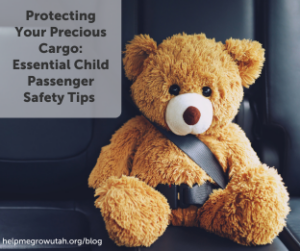 Did you know that at least 60% of car seats are installed incorrectly? When your child’s safety is on the line, learning about passenger safety will always be worth it (Utah Child Passenger Safety). Seat belts are the most effective safety measures to avoid injury or death when driving in a car, and knowing how to use them correctly with car seats can make all the difference when it matters most. While there are endless opportunities to enjoy Utah’s natural beauty on family outings and day-to-day travel, it is essential to ensure our little ones are secure while on the road. So, what should you know? Here are a few things to get started!
Did you know that at least 60% of car seats are installed incorrectly? When your child’s safety is on the line, learning about passenger safety will always be worth it (Utah Child Passenger Safety). Seat belts are the most effective safety measures to avoid injury or death when driving in a car, and knowing how to use them correctly with car seats can make all the difference when it matters most. While there are endless opportunities to enjoy Utah’s natural beauty on family outings and day-to-day travel, it is essential to ensure our little ones are secure while on the road. So, what should you know? Here are a few things to get started!
Understanding Child Passenger Safety Laws in Utah
Utah law mandates that all passengers must wear seat belts in all seating positions and that all children under the age of 8 must be secured in an appropriate child safety seat. However, it’s essential to recognize that having a car seat isn’t enough; it must be installed and used correctly to maximize safety during every drive. (Utah Department of Safety)
Car Seat Safety
The American Academy of Pediatrics recommends children remain in each car seat stage until the maximum of the car seat. Frequently, that means 3-5 year olds can (and should) remain rear-facing longer than you think. Rather than looking at the minimum height and weight to see if your kids can move to the next stage, look at the maximum height and weight to see if your kids can still remain in the safest option.
- Infants: Must be in a rear-facing car seat. This could be an infant seat or a convertible car seat.
- Toddlers: Should remain in a rear-facing seat as long as possible, according to the manufacturer’s weight and height limits.
- Children: After outgrowing the rear-facing seat, children should remain forward-facing in a harnessed seat until they exceed the weight or height limit. After that, they should transition to a booster seat until they are at least 4’9” tall and fit a seat belt correctly.
- All children under 13 years old should ride in the back seat.
Again, remember that these are the minimum requirements. For optimal safety, keep children in the appropriate seat for as long as possible.
Choosing the Right Car Seat
Selecting the correct car seat for your child involves considering their age, weight, and height. Here’s a brief breakdown of the types of car seats available, see this Facts About Car Seats infographic for more information.
- Infant Car Seats: Designed for newborns and small babies, these seats are always rear-facing and have a weight limit typically up to 30-35 pounds.
- Convertible Car Seats: These can be used in both rear-facing and forward-facing positions, making them a versatile choice as your child grows. Most can accommodate a newborn.
- Booster Seats: Used for older children who have outgrown their forward-facing harnessed car seat but are not yet tall enough to use a seat belt alone.
- All-in-One Seats: These seats can be used from birth and transition from rear-facing to forward-facing to booster, providing a long-term solution.
Tips for Selecting a Car Seat:
It’s important to note that there has been a recent increase in counterfeit car seats. With the popularity and convenience of online shopping, these illegal and unsafe seats pose a serious threat to child passenger safety. Consider the powerful example of an unsuspecting Utah mom who learns that her car seat is fake during her hospital release car seat check (read the full story here).
To avoid unintentionally putting your child at risk, be vigilant in checking your child’s car seat for the safety features included in all legal and safe seats sold in the U.S., and beware of third-party car seat sellers on reputable online websites, like Amazon and Walmart. When deciding if a seat is legitimate or not, look for missing parts (e.g., thin straps or missing chest clip), correct labeling (e.g. height and weight requirements, comprehensive visual and written instructions), and a manufacturing label. A new seat will always come with a registration card so the manufacturer can reach out if there is a problem with it. Suspiciously low prices are also a very good indicator that a car seat is fake, so don’t be fooled by a seemingly good deal. Learn more about spotting counterfeit car seats through Click It Utah.
The best way to ensure your seat fulfills all safety requirements is to get it inspected for free by a certified Child Passenger Safety technician. Safe Kids Utah offers free car seat inspections by certified technicians throughout the state, usually through a local health department. Find a technician closest to you here. Note that most fire and police departments in Utah do not have certified technicians.
In Utah, Intermountain Health also offers free in-person (Lehi or Salt Lake) or virtual car seat check inspections. Call 801-662-6583 to set up an appointment.
- Check the Fit: Ensure the seat fits securely in your vehicle. Refer to your vehicle’s manual and the car seat’s installation guide.
- Compatibility: Choose a car seat that is compatible with your vehicle’s seat belts or LATCH system.
- Safety Ratings: Look for car seats that have high safety ratings from independent testing organizations.
Proper Installation of Car Seats
Even the safest car seat won’t protect your child if it’s not installed correctly. Here are steps to ensure proper installation:
- Read the Manuals: Familiarize yourself with both the car seat and vehicle owner’s manuals.
- Securely Install the Seat: Use either the seat belt or LATCH system to secure the car seat. Ensure there’s no more than one inch of movement when you check at the belt path with the firmness of a handshake.
- Check the Angle: For rear-facing seats, make sure they are at the correct angle to prevent your child’s head from flopping forward.
- Harnessing Your Child: Ensure that the harness straps are snug and that the chest clip is at armpit level.
Common Installation Mistakes to Avoid
- Incorrect angle: Rear-facing seats should recline to a vertical angle of 30-45 degrees.
- Loose harness: A snug harness is crucial; you should not be able to pinch any slack at the shoulder.
- Forward-facing too soon: Always keep your child rear-facing as long as possible, until they have reached the max height and weight of the seat. It is completely safe and normal, if your child’s legs are bunched up.
- Clothing: Bulky clothing can impact harness fit; add a coat or additional blankets over the top of the harness rather than underneath
Transitioning to the Next Stage
Children grow quickly, and transitioning to the next type of car seat is a common challenge for parents. Here’s how to know when it’s time to make the switch:
- Rear-Facing to Forward-Facing: Your child can transition to a forward-facing seat once they reach the maximum weight or height limit for their rear-facing seat.
- Forward-Facing to Booster: Move to a booster seat once your child outgrows their forward-facing car seat.
- Booster to Seat Belt: A child can use a seat belt alone when they reach 4’9” tall and can appropriately fit a seat belt.
To determine whether your child is ready for a seat belt or not, ask yourself the following questions. If the answer to all of them is “yes”, it is safe for them to use a seat belt.
- Can your child sit all the way back in the seat (no gap behind their bottom)?
- Do their knees bend at the edge of the seat?
- Are their feet flat on the floor?
- Does the seat belt fit low across the hips (not the stomach) and across the middle of their collar bone?
- Can the child sit that way through the entire trip?
Safety Tips for Traveling with Children
Traveling with children can be challenging, but there are several tips to enhance safety:
- Plan for Breaks: On longer trips, schedule breaks to let your child and yourself stretch and have a bathroom break.
- Never Leave a Child Alone in the Car: This includes even for a few minutes; temperatures can rise quickly, putting your child at risk.
- Educate Your Children: Teach them about the importance of wearing seat belts and being safe in the vehicle by being the example. Children model what they see.
Additional Resources for Utah Parents
For more information on child passenger safety, consider these valuable resources:
- Safe Kids: The Ultimate Car Seat Guide
- Click It Utah: Information and Resources
- National Highway Traffic Safety Administration: Car Seat Check Locator:
- Healthy Children: Car Seats: Information for Families
- Intermountain Health: Car Seat Safety Card (Spanish Version)
- Buckle Up NC: Updated Recall List
- Healthy Children: 2024 Car Seat Product Listing
If you take away one thing from this article, I hope it’s that child passenger safety is a critical issue that demands every parent’s attention and ongoing education. Continue to learn how to safeguard your family against preventable injury by reviewing the above resources to stay up-to-date and share this knowledge with friends, family, caregivers, and neighbors. Everyone will benefit from it. Be safe out there!
Special thanks to Marla Brannum, Safe Kids Utah County Coordinator for reviewing and verifying the accuracy of this article.





